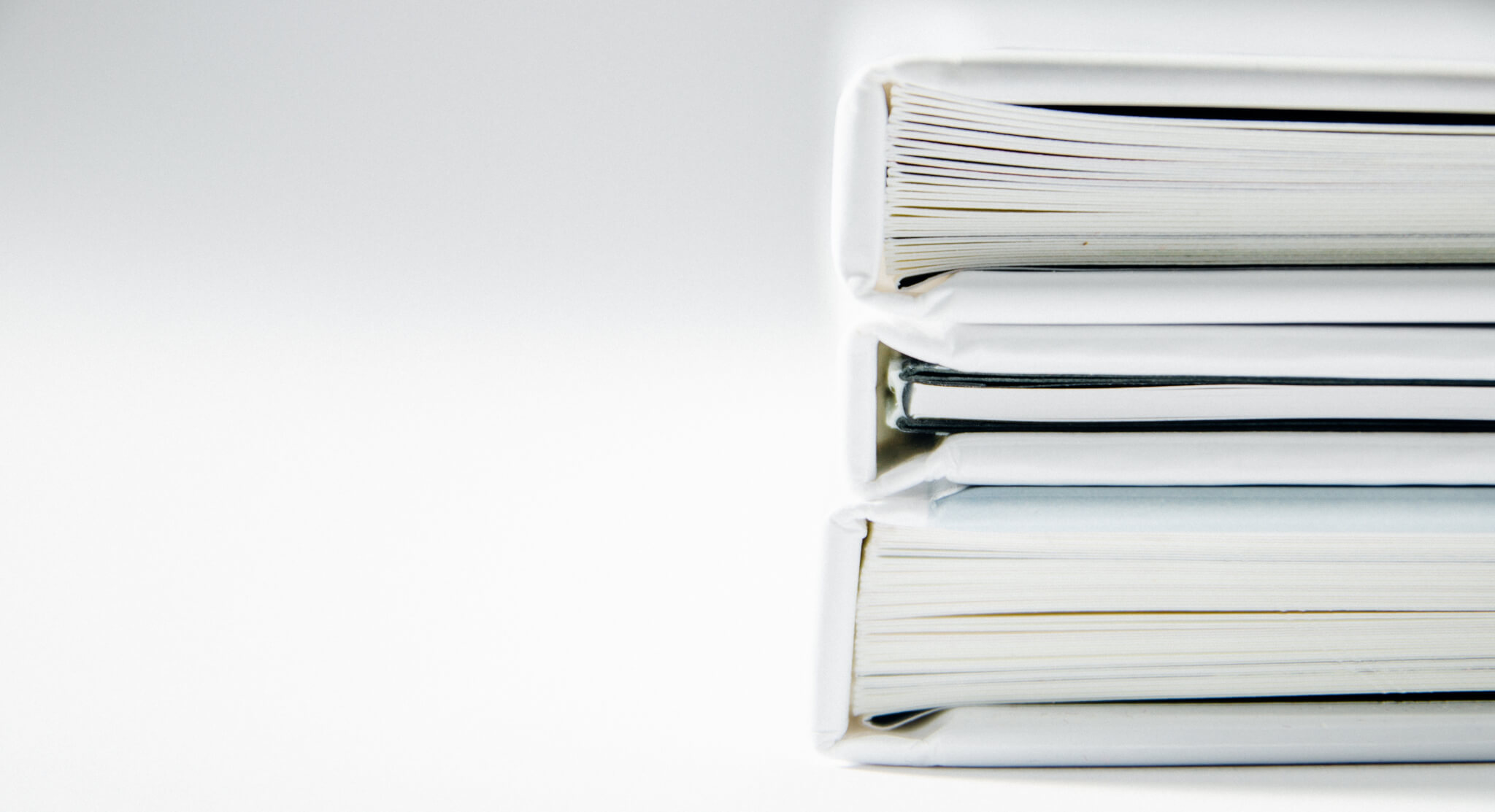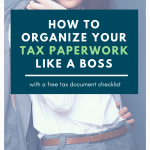How to Organize Your Tax Paperwork Like a Boss

Short and Sweet Summary: Taxes are complicated enough but worse if you don’t know how to organize your tax paperwork. Do yourself a huge favor and learn how to organize your documents so tax time won’t be so overwhelming. You’ll be glad you’re so well prepared.
So, taxes.
The beginning of a new year brings lots of hope, new beginnings, resolutions..and tax documentation. Mortgage interest and W-2’s and interest income, oh my! It’s damn near impossible to keep track of your tax paperwork if you aren’t putting it in a folder. You need to organize your tax paperwork so that you can find what you need without pulling your hair out of your head.
Just buy a folder, label it “Personal Taxes (insert year)” and make sure you keep all of the documents you receive at the beginning of the year in this folder. Whether you do your own taxes or hire someone else to do them, it’s essential to keep your paperwork in one location. Not scattered on your desk or in piles on your floor. Or in different folders.
Like I used to do.
It doesn’t work.
When it comes to taxes, the more prepared you are the better. Lots of tax documentation paperwork exists ranging from income reports to deductions that lower your adjusted gross income. It’s important to organize your tax paperwork so when it comes time to file, you have everything in one central location.
CREATE A TAX DOCUMENTATION FOLDER
I’ve raided my kids’ school supplies cabinet for folders. I’ve used manilla folders in my filing cabinet. And I’ve purchased pretty flowered-covered folders because shouldn’t a tax documentation folder be pretty? Pick a folder, any folder, to keep all of your tax documents in. When you receive mail with the notation, “Tax Documents Enclosed” open it immediately and plop the paperwork in the folder. You don’t have to look at it, read it, or understand it at this point. Just begin to organize your tax paperwork and put it in the folder until you are ready to tackle your taxes.
KEEP TRACK OF RECEIPTS
Receipts are the bane of my existence. I abhor keeping and organizing receipts. HATE. But, I have to keep receipts for my business expenses. So, hate it or not, I gotta do it. Here are some ideas to keep track of receipts that will save your sanity.
- Use a coupon-size expanding folder. Label the sections according to the receipts you itemize like Household, Medial, Business, Charitable, Childcare, etc.
- Opt for email receipts instead of paper receipts and keep an electronic copy of receipts in your email or another computer file.
- Use a receipt scanner like the Neat Receipt Portable Scanner. Just scan your receipts and the smart organization software categorizes and files your documents.
- Use the Neat mobile app. Take pictures of receipts with your phone’s camera and store on your desktop or your device.
WHAT INCOME DOCUMENTS TO LOOK FOR
After the beginning of the year, you will start to receive documents either in the mail, or electronically if you’ve opted out of mail service, for many of the following items:
- W-2: if you are an employee and earned income from which social security taxes or Medicare tax was withheld, you will receive a W-2. This means you worked for someone else.
- 1099-MISC: If you’re self-employed or an independent contractor, you will receive a form 1099-MISC which reports any self-employment income of $600 or more.
- 1099-INT: Reports interest income from accounts that pay you interest, like bank accounts.
- 1099-DIV: Reports dividend income from stock or mutual fund investments. Dividends are earnings paid directly to shareholders.
- 1099-R: Reports distributions from pensions, annuities or retirement accounts.
- 1099-S: Reports distributions from real estate transactions (sale of the property).
- 1099-SA: Reports distributions from a Health Savings Account (HSA).
- SSA-1099: Reports distributions from social security accounts.
- Rental Property income
- Miscellaneous income (gambling, jury duty, etc.)
All of these documents will report the income you’ve received. If you receive a 1099, so did the IRS. Make sure you include all 1099s on your tax return. If you properly organize your tax paperwork, you will have copies of everything the IRS has copies of.
HOW TO LOWER YOUR AGI TO PAY FEWER TAXES
No one likes to pay taxes, so it’s imperative that you know how to reduce your taxable income. Your Adjusted Gross Income (AGI) is your income minus any adjustments/reductions. Many adjustments to your income allow you to lower the amount you owe in taxes. If you organize your tax paperwork accordingly, you can see what income is reducible.
Yippee!
For example, I have a Health Savings Account (HSA) and any contributions I make to the HSA (up to $7,100 per year) lower my adjusted gross income. To make this super simple, if I make 40,000 per year in gross income and I contribute the max to my HSA, I only pay taxes on $32,900 ($40,000 – $7,100 = $32,900).
If any of the following apply to you, make sure to take advantage of the adjustments by providing the tax paperwork to your tax preparer or entering on your tax software. You may receive some tax forms in the mail or you may have to review purchase receipts. If you organize your tax paperwork from the beginning of the year, these steps shouldn’t be too complicated.
Make copies of any and all documents pertaining to these adjustments and keep them in your folder. You can make adjustments to your income with the following items:
- HSA contributions (this comes on a 5498-SA Tax Form)
- Health Insurance payments for self-employed (you take this deduction on Form 1040, line 29)
- IRA contributions (based on limits if you’re also covered by a company plan)
- Contributions to self-employed pension plans like SEP, etc. (deducted on Form 1040 on the line for self-employed SEP, SIMPLE, and qualified plans)
- Student loan interest paid (Form 1098-E)
- Tuition paid (Form 1098-T)
- Teachers – expenses paid for classroom supplies. Keep copies of receipts.
- Energy-Efficient Home Improvements – if you’ve replaced windows, furnace or air-condition or hot water heater, etc., keep all receipts and paperwork of energy-efficient ratings.
TAKE ADVANTAGE OF DEDUCTIONS AND CREDITS
You can deduct certain things to help lower your taxable income or apply for credits that reduce taxes directly. Make sure you take advantage of the following ways to use deductions and credits. See Credits and Deductions for Individuals for a complete list. Organize your tax paperwork efficiently by keeping copies of the following in your tax folder:
- Mortgage Interest Statement: Reports interest paid on your mortgage for the tax year which you can claim as a deduction on your taxes.
- Property Tax applies only to the main home. Keep copies of both summer and winter tax payments.
- Charitable Donations: Keep receipts for any cash amounts or value of a donated property.
- Childcare Costs: this is only for children under age 13 (or disabled at any age) and includes not only daycare costs but also costs of babysitters and summer day camps if those costs were incurred while you were at work (overnight summer camps don’t count).
- Moving Expenses: only if your expenses relate to moving for a new job or transferring current job.
- Interest Expenses
- Home Business Expenses
- Work-related educational expenses
Deductions and credits are based on several criteria. Please be sure to do your due diligence if you’re preparing your own taxes.
WIDOW WRAP UP
Organizing tax paperwork is a drag, but ultimately necessary and completely sanity-saving since you will have everything you need in one place.
It’s much easier to file away your tax documents as soon as you receive them or keep track of your receipts and taxes already paid if you organize them in a file folder that stays together. I spent too many months searching for tax documents the first year after my husband died.
Once my accountant told me what I needed, I made a checklist. Now I know what I need to include in my tax organization documents every year.
As soon as I pay my property taxes, a copy goes in my tax documentation folder. Whenever I donate to a charitable organization, the receipt goes in my tax documentation folder. And on and on.
Do yourself a huge favor and organize your tax documents in a file folder. When tax time rolls around it won’t be so overwhelming. You’ll be glad you were so well prepared.
Go you!

